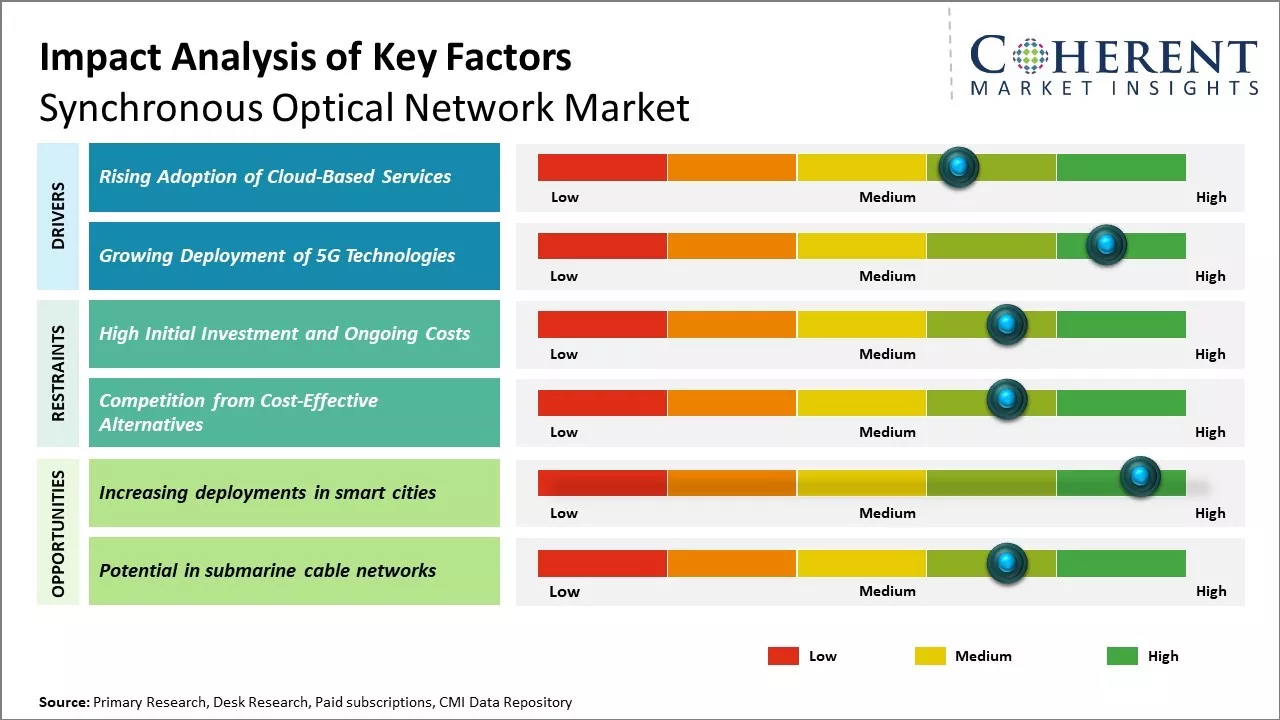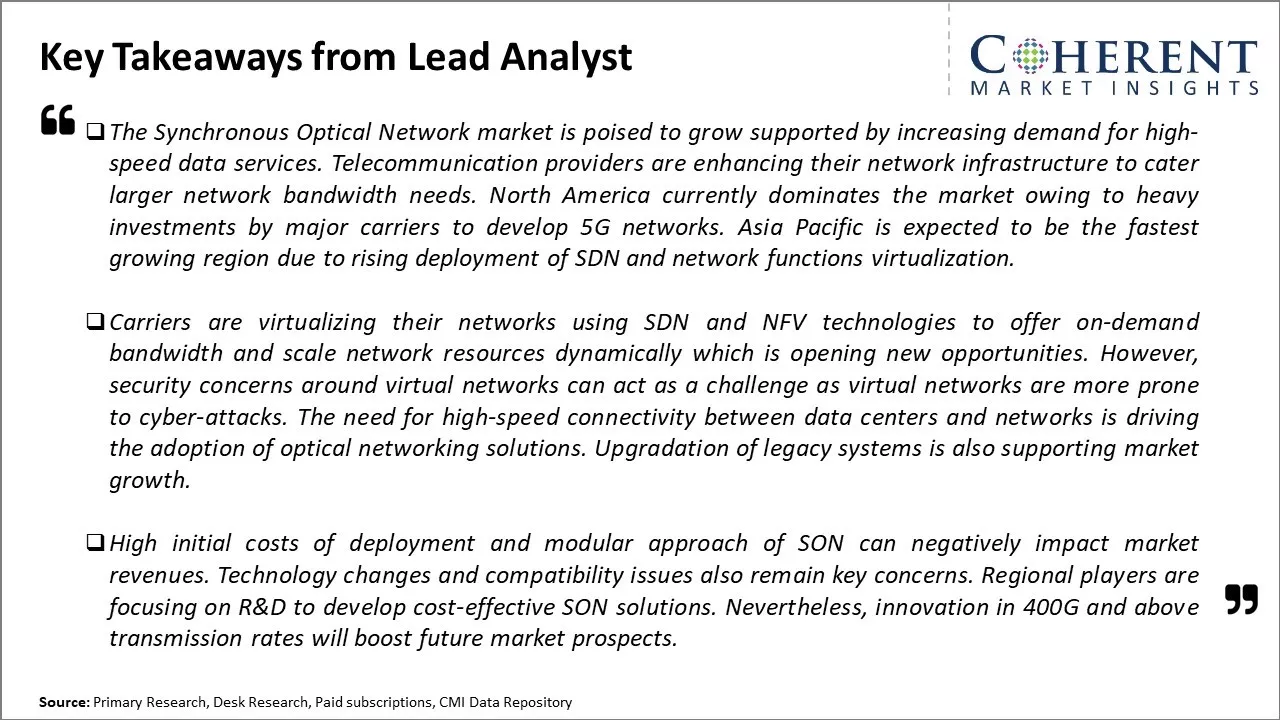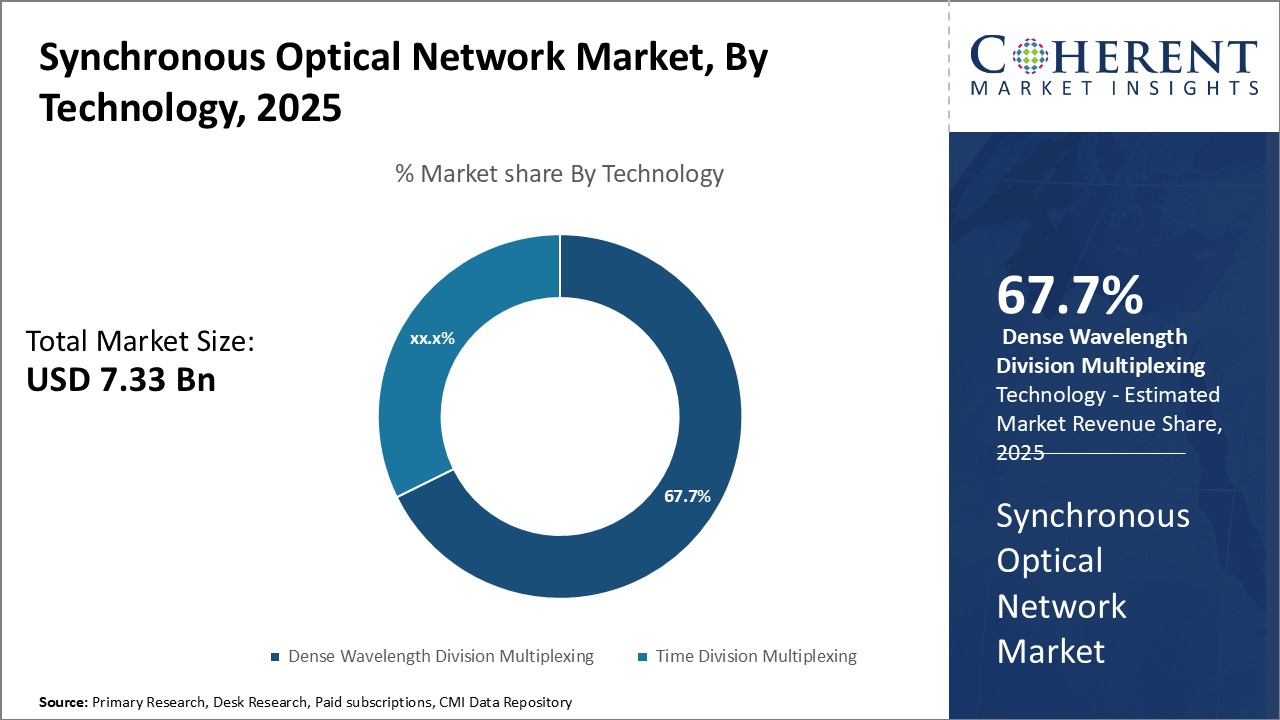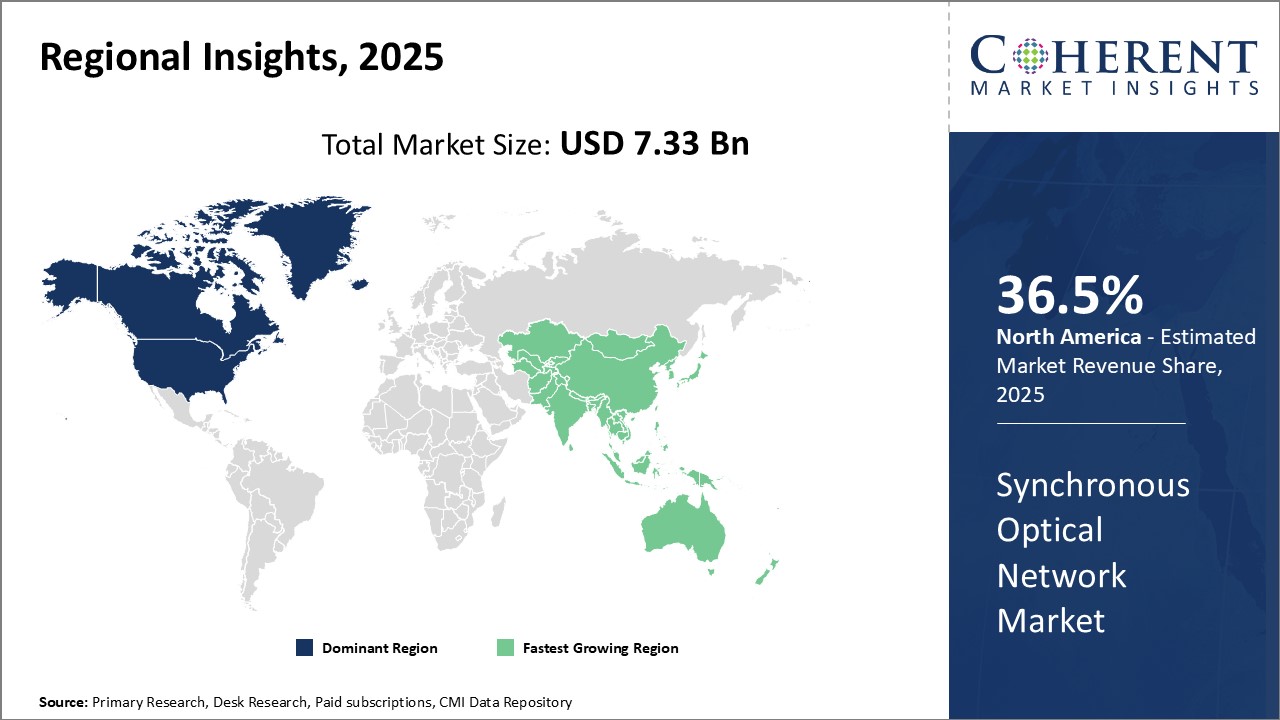Synchronous Optical Network Market Size and Trends
Global synchronous optical network market is estimated to be valued at USD 7.33 billion in 2025 and is expected to reach USD 13.24 billion by 2032, exhibiting a compound annual growth rate (CAGR) of 8.8% from 2025 to 2032. Synchronous optical networking is increasingly being adopted by telecommunication companies and large enterprises to cater to the exponentially growing demand for bandwidth and need for high-speed data transmission.

Discover market dynamics shaping the industry: Download Free Sample
The market is expected to witness significant growth over the forecast period. Traditional optical networking technologies are unable to meet current and future network requirements in terms of speed and capacity. Synchronous optical networking provides higher bandwidth, low latency and packet-level synchronization required by many modern networking applications such as 5G, artificial intelligence, and Internet of Things. The growing requirement for such applications boosts demand for synchronous optical networks globally.
Rising Adoption of Cloud-Based Services
Global synchronous optical network market is witnessing substantial growth due to rising adoption of cloud-based services across industries globally. Cloud computing has revolutionized how information technology services are delivered and being leveraged by organizations of all sizes. Public cloud services provide huge scalability and flexibility to businesses at competitive rates. This has increased the reliance of companies on cloud infrastructure and apps. As more enterprise workloads and digital services shift to the cloud, there is a growing need for high-speed networks that can support this migration and allow seamless connectivity between data centers, cloud platforms, and end users. Synchronous optical networks with their ability to provide symmetrical bandwidth and low latency communications has become increasingly important. These networks help data centers and cloud providers to achieve higher performance and connectivity required for mission critical cloud applications. These allow cloud service providers to scale up their infrastructure quickly and efficiently in different geographical locations. This boosts adoption of SON solutions within large cloud platforms.
For instance, in April 2021, Shanghai became the first city worldwide to deploy fully-optical network city-wide. Anywhere in the urban area, user can experience a stable connection with a network latency of only 1 millisecond.
Market Concentration and Competitive Landscape

Get actionable strategies to beat competition: Download Free Sample
Growing Deployment of 5G TechnologiesAnother key driver propelling the synchronous optical network market growth is the rapid deployment of 5G technologies worldwide. 5G promises to deliver significantly enhanced mobile broadband services with ultra-low latency and massive connectivity. However, it also places immense pressure on the backhaul infrastructure that connects the core network with 5G radio sites. Synchronous networks have emerged as an effective solution to meet the exponential increase in bandwidth requirements of 5G. Their symmetrical capabilities enable seamless transmission of bandwidth-intensive data between core network centers and cell sites. These help optimize 5G backhaul networks and allow telcos to upgrade core infrastructure without disruptions. SON solutions also support high-performance fronthaul applications in 5G networks, facilitating functions like RoF and C-RAN. Increasing 5G deployments by telecom operators to fulfil government mandates and meet consumer demand for faster speeds boosts long-term investment in SON. The technology enables telcos to upgrade networks and roll-out new-age services with reliability and ease.
In February 2023, GSMA Intelligence, the definitive source of data and analysis for the mobile industry and beyond, covering all operators across the globe, released updated data indicating that 5G connections are expected to double in 2024. This growth is accelerated by advancements in technology and the initiation of 5G network installations in over 30 nations in 2023. Out of the networks set to be launched in 2023 , approximately 15 are anticipated to be 5G standalone networks.

To learn more about this report, Download Free Sample
Market Challenges: High Initial Investment and Ongoing CostsOne of the key challenges faced by the synchronous optical network market is the high initial investment required for setting up SONET infrastructure. Establishing SONET networks entails significant capital expenditure on hardware equipment such as multiplexers and switches. Periodic upgradation of technology also pushes the investment costs higher. Further, maintenance and operation of such networks demands specialized skilled professionals which increases the operational expenses. The market is also witnessing increased competition from cheaper alternative optical networking technologies such as Optical Transport Network (OTN) which can hinder the growth potential of market.
Market Opportunities: Increasing deployments in smart cities
Development of smart cities globally provides an excellent opportunity for synchronous optical network (SONET) adoption. Smart cities utilize digital connectivity for automating and integrating various urban systems. Synchronous optical network (SONET) can provide the high-capacity fiber optic backbone required for enabling seamless connectivity across smart city infrastructure. According to projections, the global smart city market will grow from US$ 410 billion in 2020 to over US$ 820 billion by 2025 at a CAGR of 14.7%. The rapid proliferation of smart cities will boost demand for synchronous optical network (SONET) deployments.

Discover high revenue pocket segments and roadmap to it: Download Free Sample
Insights, By Technology- Growing need for higher bandwidth boosts adoption of Dense Wavelength Division Multiplexing TechnologyIn terms of technology, dense wavelength division multiplexing segment is expected to contribute the highest share of 67.7% in 2025, owing to its ability to support higher bandwidth demands. Dense wavelength division multiplexing allows multiple optical carrier signals to be multiplexed onto a single optical fiber using different wavelengths. This significantly increases available bandwidth as compared to conventional time division multiplexing technology. The continued growth of bandwidth-intensive applications such as video streaming, virtual/augmented reality, cloud computing and big data analytics boosts demand for higher network capacities. Dense Wavelength Division Multiplexing is increasingly becoming the preferred choice for network operators seeking scalable and cost-effective solutions to deliver multi-terabit capacities over single mode fibers.
Insights, By Components- Optical fiber segment holds dominant share due to its vital role in SONET infrastructure
In terms of components, optical fiber segment is expected to contribute the highest share of 43.41% in 2025, owing to its central role in synchronous optical network infrastructure. Optical fiber forms the physical medium that carries optical signals between synchronous optical network elements such as ADMs and DCSs. It enables transmission over long distances with minimal signal loss and absence of electromagnetic interference. The use of optical fiber eliminates the need for repeated optical-electrical-optical conversions, thereby, improving transmission efficiency. Single mode optical fibers in particular have become indispensable for building high-speed synchronous optical networks due to capabilities like negligible pulse spreading even at ultra-high bit rates. Massive ongoing deployments of Fiber-To-The-Home networks as well as fiber deep initiatives by telcos are consistently boostsdemand for optical fibers.
Insights, By Industry Vertical- Growing deployment of high-bandwidth networks in IT & Telecom vertical drives the segment growth
In terms of industry vertical, IT & Telecom segment is expected to contribute the highest share of 47.21% in 2025, owing to large-scale adoption of synchronous optical networks for infrastructure build-outs. Telecommunications networks lie at the core of digital transformation and rely heavily on high-speed optical networking for seamless connectivity. Synchronous optical networks enable IT & telecom providers to deliver bandwidth-intensive applications and cloud-based services with carrier-class scalability, redundancy and quality of service. Transition to 5G also propels the need for optical networking solutions capable of transporting exponential data loads. On the enterprise front, synchronous optical networks facilitate mission-critical applications of leading technology companies through extremely robust, secure and low-latency connectivity.
Regional Insights

Need a Different Region or Segment? Download Free Sample
North America has been the dominant region in the market over the past decade and is expected to hold the highest share of 36.5% in 2025. The strong presence of global network infrastructure providers and telecommunication giants have cemented North America's leadership position. Major customers like AT&T, Verizon and CenturyLink have transitioned significant portions of their backbone and metro networks to SON technology. This provides the regional suppliers with a sizable installed base and a ready customer pipeline for upgrades. North American companies have been at the forefront of SON technology development. Leading vendors offer the most feature-rich products from their North American R&D centers, ensuring the region's networks have early access to the latest innovations.
However, Asia Pacific region has emerged as the fastest growing market for SON solutions in recent years and is expected to follow the same trend in 2025 with CAGR of 12.32%. Rapid digitization across the region's developing economies is driving massive investments in high-capacity networking. SON's ability to automatically optimize large, complex networks makes it the preferred upgrade path for tier-1 carriers like China Mobile, NTT and Telstra as they build out 5G infrastructure. The market is also receiving a boost from country-level initiatives favouring indigenous network suppliers. For example, India's network equipment mandate and China's 'Secure and Controllable' policy have strengthened local SON vendors. As a result, global providers are expanding their Asia Pacific presence through partnerships and acquisitions. The region's massive scale, positive regulatory environment and demand from telecom modernization present a significant long-term growth opportunity for SON technology adoption.
Market Report Scope
Synchronous Optical Network Market Report Coverage
| Report Coverage | Details | ||
|---|---|---|---|
| Base Year: | 2024 | Market Size in 2025: | USD 7.33 Bn |
| Historical Data for: | 2020 To 2024 | Forecast Period: | 2025 To 2032 |
| Forecast Period 2025 to 2032 CAGR: | 8.8% | 2032 Value Projection: | USD 13.24 Bn |
| Geographies covered: |
|
||
| Segments covered: |
|
||
| Companies covered: |
ADVA Optical Networking SE, Alcatel- Lucent Inc., Anritsu, Ciena Corporation, Cisco Systems Inc., Cypress Semiconductor Corporation, ECI Telecom Ltd., Ericsson Inc., Fujitsu Ltd., Huawei Technology Co. Ltd., Infinera Corporation, JDS Uniphase Corporation, Juniper Networks Inc., Microsemi Corporation, MRV Communications Inc., Nokia Corporation, Oscilloquartz, Smartoptics, Telefonaktiebolaget LM Ericsson, Verizon Communication Inc, Zayo Group Holdings Inc., ZTE Corporation |
||
| Growth Drivers: |
|
||
| Restraints & Challenges: |
|
||
Uncover macros and micros vetted on 75+ parameters: Get instant access to report
Synchronous Optical Network Industry News
- In September 2023, the National Telecommunications and Information Administration (NTIA) under the Department of Commerce of U.S. disclosed the allocation of 28 grants totaling US$ 74,424,986.73 to 28 tribal organizations through the Tribal Broadband Connectivity Program (TBCP). This financial support, part of President Mr. Joe Biden's internet for all initiative, aims to directly connect tribal homes and businesses to fast internet services, plan for upcoming internet infrastructure projects, and enhance existing network equipment.
- Recent data released by India's Department of Telecommunications (DoT) indicates a significant surge in the number of 5G base stations across the country. As of now, there are a total of 308,466 5G base stations, marking a substantial rise from the 53,590 recorded in early 2023. Jio reportedly has the largest 5G footprint with 254,000 deployed base stations, while Airtel has deployed 60,000. The 5G rollout in India, initiated by Jio and Airtel in October 2022, has significantly improved mobile data speeds, according to network analytics company Ookla. The operators have expanded coverage, relying on new spectrum bands acquired during the country’s 5G auction in August 2022, which raised a total of USD 18.5 billion.
- In April 2021, Shanghai became the first city worldwide to deploy a fully-optical network city-wide, providing users with a stable connection and a network latency of only 1 millisecond across the urban area
- In May 2021, ADVA a telecommunication equipment provider, launched the FSP 150-XG118Pro, a new edge device designed for open optical transport networks. This device simplifies and secures the aggregation, filtering, and routing of up to 16 services over a single optical port.
- In May 2021, Infinera unveiled metro-focused 400G pluggable optics solutions tailored for the XTM Series and GX Series compact modular platforms. These additions enhance the adaptability and cost-efficiency of metro networks, supporting network operators in expanding their networks in response to growing bandwidth demands.
Definition: Synchronous Optical Network Market involves the development and sale of synchronous optical networking (SONET) and synchronous digital hierarchy (SDH) equipment. SONET and SDH technologies facilitate the high-speed digital transmission of multiple signals and formats over fiber-optic networks. Key products in this market include optical line terminals, digital cross-connect systems, multiplexers, and regenerators that allow telecommunication carriers and enterprises to efficiently transmit large amounts of data over long distances using fiber-optic cables.
Market Segmentation
- Technology Insights (Revenue, USD Bn, 2020 - 2032)
- Time Division Multiplexing
- Dense Wavelength Division Multiplexing
- Components Insights (Revenue, USD Bn, 2020 - 2032)
- Optical fiber
- Optical transceiver
- Fiber optic circulators
- Optical amplifiers
- Optical splitters
- Others
- Industry Vertical Insights (Revenue, USD Bn, 2020 - 2032)
- IT & Telecom
- BFSI
- Healthcare
- Government & Defense
- Transportation & Logistics
- Others
- Regional Insights (Revenue, USD Bn, 2020 - 2032)
- North America
- U.S.
- Canada
- Latin America
- Brazil
- Argentina
- Mexico
- Rest of Latin America
- Europe
- Germany
- U.K.
- Spain
- France
- Italy
- Russia
- Rest of Europe
- Asia Pacific
- China
- India
- Japan
- Australia
- South Korea
- ASEAN
- Rest of Asia Pacific
- Middle East & Africa
- GCC Countries
- South Africa
- Israel
- Rest of Middle East & Africa
- North America
- Key Players Insights
- ADVA Optical Networking SE
- Alcatel- Lucent Inc.
- Anritsu
- Ciena Corporation
- Cisco Systems Inc.
- Cypress Semiconductor Corporation
- ECI Telecom Ltd.
- Ericsson Inc.
- Fujitsu Ltd.
- Huawei Technology Co. Ltd.
- Infinera Corporation
- JDS Uniphase Corporation
- Juniper Networks Inc.
- Microsemi Corporation
- MRV Communications Inc.
- Nokia Corporation
- Oscilloquartz
- Smartoptics
- Telefonaktiebolaget LM Ericsson
- Verizon Communication Inc
- Zayo Group Holdings Inc.
- ZTE Corporation
Share
Share
About Author
Monica Shevgan has 9+ years of experience in market research and business consulting driving client-centric product delivery of the Information and Communication Technology (ICT) team, enhancing client experiences, and shaping business strategy for optimal outcomes. Passionate about client success.
Missing comfort of reading report in your local language? Find your preferred language :
Transform your Strategy with Exclusive Trending Reports :
Frequently Asked Questions
EXISTING CLIENTELE
Joining thousands of companies around the world committed to making the Excellent Business Solutions.
View All Our Clients
